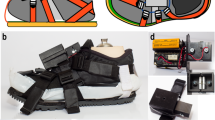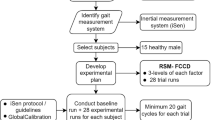Abstract
Trip** while walking has been identified as the most common cause of falls among the elderly as they tend to utilize a shuffling gait while walking, which increases the risk of falling. Since trip** occurs when toes make unexpected contact with objects on the floor, a number of studies have investigated the impact of foot clearance on the risk of trip**. However, only a few studies have examined the effects of foot–floor friction on the risk of trip**. Thus, in this current study, we investigated the effect of foot–floor friction on the probability of trip-induced falls during normal and shuffling gaits in a computational simulation study. We used a computational model with neural rhythm generators and neuromusculoskeletal systems to simulate gait in a self-organized manner. By changing the parameters of the neural rhythm generator, gait parameters such as step length, cadence, and foot clearance were automatically reduced, which simulated the shuffling gait. To alter the foot–floor friction, we changed the spring coefficient ratio of the floor in horizontal and vertical directions. As per our results, it was determined that slip-induced falls occurred under low foot–floor friction conditions in both normal and shuffling gaits, whereas trip-induced falls occurred under high foot–floor friction conditions only with a shuffling gait. These results suggest that optimal foot–floor friction may prevent trip- and slip-induced falls among the elderly.
Access this chapter
Tax calculation will be finalised at checkout
Purchases are for personal use only
Similar content being viewed by others
References
Talbot, L.A., Musiol, R.J., Witham, E.K., Metter, E.J.: Falls in young, middle-aged and older community dwelling adults: perceived cause, environmental factors and injury. BMC Publ. Health 5(86), 1–9 (2005)
Kim, H., et al.: Are gait parameters related to knee pain, urinary incontinence and a history of falls in community-dwelling elderly women? Jpn. J. Geriatr. 50, 528–535 (2013). (in Japanese)
Lord, S.R., Lloyd, D.G., Li, S.K.: Sensori-motor function, gait patterns and falls in community-dwelling women. Age Ageing 25, 292–299 (1996)
McKenzie, N.C., Brown, L.A.: Obstacle negotiation kinematics: age-dependent effects of postural threat. Gait Posture 19(226–234), 20 (2004)
Wang, Y., Wang, S., Bolton, R., Kaur, T., Bhatt, T.: Effects of task-specific obstacle-induced trip-perturbation training: proactive and reactive adaptation to reduce fall-risk in community-dwelling older adults. Aging Clin. Exp. Res. 32, 893–905 (2020)
Menz, H.B., Morris, M.E., Lord, S.R.: Footwear characteristics and risk of indoor and outdoor falls in older people. Gerontology 52, 174–180 (2006)
Yamaguchi, T., Yano, M., Onodera, H., Hokkirigawa, K.: Effect of turning angle on falls caused by induced slips during turning. J. Biomech. 45, 2624–2629 (2012)
Yamaguchi, T., Yano, M., Onodera, H., Hokkirigawa, K.: Kinematic of center of mass and center of pressure predict requirement at shoe–floor interface during walking. Gait Posture 38(2), 209–214 (2013)
Chang, W.-R., Leclercq, S., Lockhart, T.E., Haslam, R.: State of science: occupational slips, trips and falls on the same level. Ergonomics 59, 861–883 (2016)
Taga, G., Yamaguchi, Y., Shimizu, H.: Self-organized control of bipedal locomotion by neural oscillators in unpredictable environment. Biol. Cybern. 65, 147–159 (1991)
Author information
Authors and Affiliations
Corresponding author
Editor information
Editors and Affiliations
Rights and permissions
Copyright information
© 2022 The Author(s), under exclusive license to Springer Nature Switzerland AG
About this paper
Cite this paper
Yamaguchi, T., Nakatani, K., Hirose, T., Yoshida, T., Masani, K. (2022). Effects of Foot–Floor Friction on Trip-Induced Falls During Shuffling Gait: A Simulation Study. In: Black, N.L., Neumann, W.P., Noy, I. (eds) Proceedings of the 21st Congress of the International Ergonomics Association (IEA 2021). IEA 2021. Lecture Notes in Networks and Systems, vol 223. Springer, Cham. https://doi.org/10.1007/978-3-030-74614-8_104
Download citation
DOI: https://doi.org/10.1007/978-3-030-74614-8_104
Published:
Publisher Name: Springer, Cham
Print ISBN: 978-3-030-74613-1
Online ISBN: 978-3-030-74614-8
eBook Packages: EngineeringEngineering (R0)




